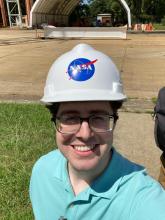deep-learning
Mentors and Regional Facilitators
| Name | Region | Skills | Interests |
|---|---|---|---|
| Aniruddha Maiti | ACCESS CSSN, Campus Champions | ||
| Alana Romanella | Campus Champions | ||
| Michael Blackmon | Campus Champions, ACCESS CSSN | ||
| Kevin Brandt | Campus Champions, Great Plains, CCMNet | ||
| Bala Desinghu | ACCESS CSSN, Campus Champions, CAREERS, Northeast | ||
| Daniel Morales | Campus Champions | ||
| Deborah Penchoff | Campus Champions | ||
| Daniel Howard | ACCESS CSSN, Campus Champions, CCMNet, RMACC | ||
| David Liu | CCMNet | ||
| David Ryglicki | |||
| Daniel Sierra-Sosa | Campus Champions | ||
| Fan Chen | ACCESS CSSN | ||
| Fernando Garzon | ACCESS CSSN | ||
| Ibrahim Sheikh | CAREERS | ||
| Jeffrey Weekley | Campus Champions | ||
| Od Odbadrakh | ACCESS CSSN | ||
| Lonnie Crosby | Campus Champions, ACCESS CSSN | ||
| shuai liu | ACCESS CSSN | ||
| Mohsen Ahmadkhani | CCMNet, ACCESS CSSN | ||
| Michael Puerrer | Campus Champions, Northeast | ||
| Maryam Taeb | |||
| Dr. Nabeel Alzahrani | Campus Champions, CCMNet | ||
| Nect Admin | Great Plains, Northeast, RMACC | ||
| Jeffrey J. Nuc… | CAREERS, CCMNet | ||
| Renos Zabounidis | Campus Champions | ||
| SAI MUKKAVILLI | ACCESS CSSN, CCMNet, Campus Champions | ||
| Grant Scott | Great Plains | ||
| Xiaoqin Huang | ACCESS CSSN | ||
| Shaohao Chen | Northeast | ||
| Simon Delattre | |||
| Mohammad Al-Tahat | CAREERS, Campus Champions, CCMNet | ||
| William Lai | ACCESS CSSN | ||
| Yongwook Song | Kentucky |
Organizations
Affinity Groups
Announcements
| Title | Date |
|---|---|
| CI Pathways: Leading the Way to Effective CI Use | 02/20/25 |
| NSF requests research and education use cases for NAIRR | 02/22/24 |
| NVIDIA GenAI/LLM Virtual Workshop Series for Higher Ed | 02/17/24 |
Upcoming Events & Trainings
| Title | Date |
|---|---|
| NAIRR Pilot Office Hours | 7/08/25 |
| NAIRR Pilot Office Hours | 7/22/25 |
| NAIRR Pilot Office Hours | 8/12/25 |
Topics from Ask.CI
Knowledge Base Resources
| Title | Category | Tags | Skill Level |
|---|---|---|---|
| ACCESS HPC Workshop Series | Learning | deep-learning, machine-learning, neural-networks, big-data, tensorflow, gpu, training, openmpi, c, c++, fortran, openmp, programming, mpi, spark | Beginner, Intermediate |
| AI/ML TechLab - Accelerating AI/ML Workflows on a Composable Cyberinfrastructure | Docs | ACES, documentation, TAMU, ai, visualization, deep-learning, machine-learning, neural-networks, login, authentication, composable-systems, gpu, nvidia, slurm, bash, modules, vim, anaconda, conda, programming, python, scikit-learn | Intermediate |
| Attention, Transformers, and LLMs: a hands-on introduction in Pytorch | Learning | ai, deep-learning, machine-learning, neural-networks, pytorch | Intermediate |
Engagements

AI for Business
The research focus is to apply the pre-training techniques of Large Language Models to the encoding process of the Code Search Project, to improve the existing model and develop a new code searching model. The assistant shall explore a transformer or equivalent model (such as GPT-3.5) with fine-tuning, which can help achieve state-of-the-art performance for NLP tasks. The research also aims to test and evaluate various state-of-the-art models to find the most promising ones.
People with Expertise

Expertise

Expertise
Aniruddha Maiti
West Virginia State University
Programs
ACCESS CSSN, Campus Champions
Roles
mentor, researcher/educator, cssn

Expertise
People with Interest
Parameshwaran Pasupathy
Rutgers, the State University of New Jersey
Programs
ACCESS CSSN, CAREERS, CCMNet
Roles
student-facilitator, CCMNet

Interests

Interests
Kevin Brandt
South Dakota State University
Programs
Great Plains, CCMNet
Roles
regional facilitator, Affinity Group Leader, CCMNet

